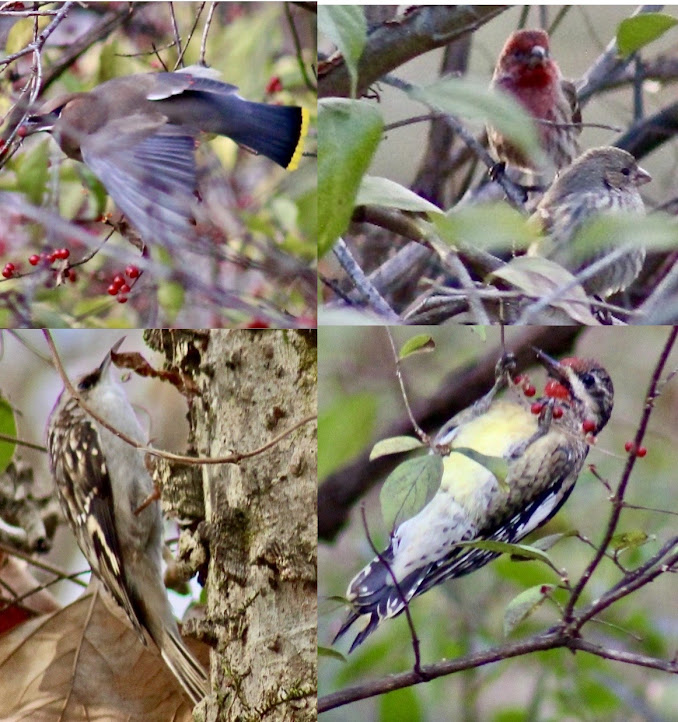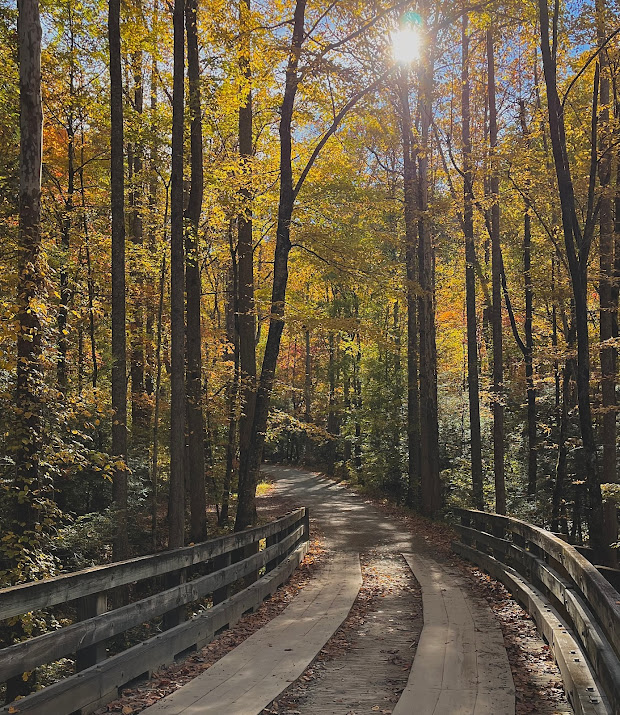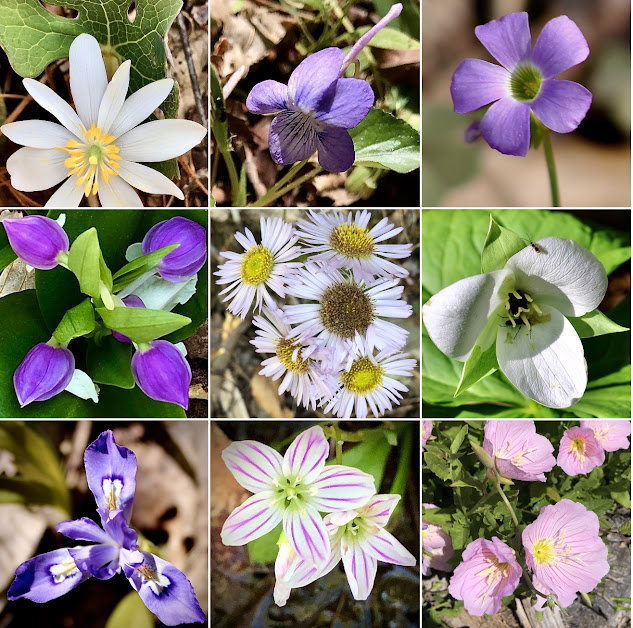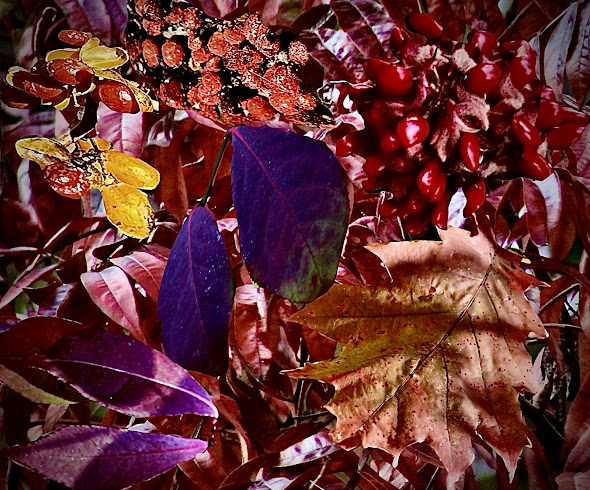Birds PART 1) Randy's Bird Photography Journey: Birds Hiding and Peeking at me from brush, twigs, and leaves
Bird Photography When They Are Peeking Out of the Brush, Vines, and Leaves....
I am finding myself trying to get good bird photographs when I see them hidden back in the brush and especially the Honeysuckle growth on my walks with my camera around my neck.
There are many much better bird photographers out there than what photos I take, but every now and then I do get a great shot. For me it is the adventure of hearing, seeing a movement in the brush or up in a tree, and zooming in, getting in focus and pushing the button.
When I am at home I go through the photos that I download from my camera card to my MacBook for viewing on the bigger screen.
Which one has good focus?
Where are the birds eyes looking?
Are the feather colors sharp?
.......and so on as I cull some out and decide which ones are keepers to drop and drag to another folder.
I do a partial screen shot of good pictures to upload for accurate identifications to iNaturalist as well as posting the location, time, and date. iNaturalist gives me sorting and filter options to use form some scientific analysis of sighting locations and time of year that species can be seen.
This is a lot of work but I love it! Especially when I capture a small bird hidden in the natural plant cover and I have good focus on the bird like this Song Sparrow back in the tall grass along Browns Creek just down the hill from my condo. This is not a perfect photo but I captured a Nature moment for me that gives me joy to be observing this little hidden bird and
Closer to Nature.....
Left click on each photo for a better view in a gallery format. You can also scroll through them with the directional arrows. To return to the main page hit escape or click the X in the upper right hand corner of the picture.
I am so lucky to live in Maryville Tennessee with my view from my elevated deck looking down to a portion of the 15 miles of Greenway trails just below me. I can go out my front condo door and walk down the hill and be at the upper end of the Greenbelt lake or cross the street and wander along the bank of Browns Creek where it joins Pistol Creek flowing into the Lake.
A local bird photographer I met on previous walks that has become a friend through these encounters and iNaturalist postings called the local Greenway system an "oasis for biodiversity" in the smaller urban area of Maryville and Alcoa, Tennessee.
There are so many micro habitats on this Greenway. Most of the paved trail miles are adjacent to Pistol Creek and some wetlands in this drainage's floodplain which makes them unsuitable for development. This provides larger space of prime bird biodiversity habitat.
I have included some links to the Greenway trails, my Canon camera, iNaturalist, and other resources at the end of this post for you to view if you would like more information.
Now it is time to get:
Closer to Nature....
with a Digital Nature Journal with Randy
This bright red Male Northern Cardinal is only partially hidden in a Bradford Pear tree that was taken a few weeks ago across the parking lot from my condo.
Left click on each photo for a better view in a gallery format. You can also scroll through them with the directional arrows. To return to the main page hit escape or click the X in the upper right hand corner of the picture.
This female Cardinal was really hiding in some stream-side dense plant growth along the Greenway. I still tried to capture an image of this lady and I am pleased with the result even with all the limbs and tangles between myself and this classy lady.
I also use a Canon 75-300 mm lens to zoom in while taking my photographs most of the time.
This Great Blue Heron photograph was hard to get the birds body and feathers in focus due to the reeds and grass in between us. I have learned to focus on the bird while zoomed out, half push down my shutter button to hold the focus, and then manually zoom in with the lens, and snap the picture to improve shooting through grass like this.
I use the auto focus setting on most of my shots and I am learning how to get the heads and faces of the birds that are partially hidden in the plant growth in focus. Sometimes I rapid press the shutter button to take multiple shots when I see I am in focus on the bird's head. Later at home I can transfer the images to my MacBook to view on the bigger screen to crop into more close up views and capture the bird's personality.
I also use Apple Photos edit tools to enhance the best ones by lightening or darkening pictures, adding just a little more of select colors, reducing the background clutter (or noise), and to sharpen the edges of the elements in the photograph.
I do try to keep these true to Nature unless I label some edited photos as abstract or artistic creations from Nature scenes I photograph (see Abstract Side bar page in this Blog link at the end of this post).
This American Robin was captured in focus after I moved slowly to get more of its body and head with a clear sightline from the green shoots growing up from this tree stump. This allowed me to use my center focus "dot" on my viewfinder of the camera to focus on the bird and not the plant growth.
My instruction manual for this Canon Rebel 7 is 326 pages long and even after 2 months since I bought it I still have not figured out how to use all the settings. I learn better by trial and error but I will look up how-to's sometimes.
This Blue Jay's head is not as crisp and in focus as I would have liked since my focus point was the small limb about 8 inches to the left from the bird's head. The head profile, the eye, and beak are okay but do not have crisp edges in this picture. I do like the glow of the blue tail feathers contrasting from the orange/tan hickory leaves in front of the Blue Jay. These color contrasts are why I chose this picture to post for a Fall photo scene.
My long time Michigan friend John Diephouse is a much better photographer then I am. He has higher quality cameras and lens and takes stunning pictures of so many subjects.
John told me he likes to capture the personalities of birds and animals. The facial expressions and eyes of birds are a way I feel I connect with these wonderful creatures with their beautiful colors and feather patterns on their small bodies.
What do you see and feel that these Song Sparrows are telling you from their eyes?
I are really proud of how I was able to use the focusing "dots" through my viewfinder and by finding just the right position of where I pointed my lens into the grass for the first 2 Song Sparrow pictures above and the leaves of the second to capture the clear head and facial personalities of these 2 birds.
Carolina Chickadees always seem to be moving so they are often difficult to even get good photographs when they are out in the open, much less back in some vines or brush. Their lack of color as mainly just the black cap, face mask and neck, white to gray body, and small size take patience and lots of shots to maybe find some good ones in focus.
Studying these photographs I see how the birds face mask just blends in with the black eyes along with any shadows in the brush makes seeing deeper into its eyes not an option. I just have to have imagination about its mood and personality!
When I first saw this little bird moving around in the Maryville College woods near my condo, I was not sure what I was photographing. I tried to just focus on its low elongated tiny body shape. It was like a Chickadee in moving all the time and creeping tightly to the trunks. The bird was flying around from tree to tree just above where I was standing on a trail.
Later I got an iNaturalist identification after I posted some pictures that this is a Brown Creeper. It has such a different tiny and unique body shape.
It was more luck this day for me getting photographs this clear as the light was low on a cloudy day and the bird was hugging tree trunks closely with leaves, vines, and limbs in my sightline.
My auto focus was often more on the tree trunks rather than the small bird's body when I chose to push my shutter button.
A very different small bird I was not aware of and I am very happy with the pictures I got. None were super clear focused but my time to photograph this little one was brief and it seemed to always be moving. The plant growth of leaves and vines was sometimes dense on tree trunks it was climbing on and in my sight line.
Another new bird species for me all of a sudden has happened twice during the last week around this 2022 Thanksgiving. Both were on the Maryville Greenway trails next to Pistol Creek.
The Cedar Waxwing is migratory and breeds and spends the warmer months in Canada. It does migrate into East Tennessee and can be found occasionally year round here.
Its physical features I love are that "Zorro" eye mask, yellow tail feather tips, the "spur" on the back of its head, the bright red wing tips, and the slick smooth finish it seems to have on the feathers on the body.
There were lots of Robins flying around when I got these pictures in the brush on the stream bank. The Robins seemed to harass and chased the pair of Waxwings I saw up the creek maybe in a territorial behavior dispute.
I was able to get the clear picture of the Waxwing perching in this tangle of tree limbs through that small window opening of the limbs.
This scene was about 25 feet away and my full 300mm zoom happened to get a good focus of the photo. When I enlarged the photo in my MacBook I cropped it down and the bird still had this quality photograph.
The next picture was me snapping away when it was moving around in a Honeysuckle bush and this inflight shot seems to show the bird grabbing a red berry while in flight.
Note the bright yellow tail feather tips which glow while the Waxwing was flying in the brush.
Next are a couple interesting photographs of a Yellow-bellied Sapsucker in some leafy bush honeysuckle and hanging onto some smaller limbs in this stream side invasive plant growth.
With these 2 pictures I saw all the movement of the bird and took my first shots with partial zoom. I held down my shutter button half way to focus on the bird's yellow belly, then zoomed in all the way with the camera lens to get the closer photograph.
It seems everybody loves seeing my pictures of the smaller Eastern Bluebird when I post them on Facebook.
The first picture below is probably a male due to its brighter colors. I call this just one of those moments in time with the bird being on the shadow side of a tree and those twigs between us did not stop me from getting a clear focus on this guy.
How his head was swiveled back looking at me was a special scene for a connection from his eyes. I think the light from the sun in the shadows made the blue wing and tail feathers have that indigo blue glow.
The next 2 pictures of these Eastern Bluebirds are most likely females with more muted blues and oranges. They were in some shadows and the leaves and limbs allowed me just enough room to get a clear in focus picture of this pretty little lady.
They were shot in sequence and I love how she holds her head up high and maybe with a little attitude saying "I am a beautiful classy lady even though the male's feathers shine a little more!"
These next 5 pictures are different birds in the brush and tangles composed of tree limbs, twigs, berries, and a few leaves. I am happy with each of these photographs as I feel I got clear in focus head shots that express the personality, mood, and attitude of each bird.
1. Blue Jay with a head lean attitude of don't mess with me!
2. This Robin singing in the top of a Bradford Pear tree happy for all this intoxicating food. Over-ripe fermented berries can cause some birds to appear to be drunk.
3. A White-throated Sparrow hidden in the tangles but with kind of a stoic facial expression. You can see the pretty layers and colors of its folded in wings and a faint white spot on its throat.
4. A fluffed up Northern Mockingbird dealing with this cold windy day and staying in this bush to block some of the frigid wind.
5. For once I saw a Titmouse who was sitting still while staying perched on a small branch among some berries while I was able to take its picture.
The next 2 pictures are a Red-bellied Woodpecker followed by a Northern Flicker. They look similar but the back patterns in the feathers are one way I have found to field ID them from each other.
The Northern Flicker has more of a small red circle on the back of its head versus the Red-bellied Woodpeckers either fully covered red head or the wide strip of red feathers on its head on the back (either female or juvenile).
I always try and get at least one good head shot with focus on their side or profile to show the back of their head.
In these 2 photos at least their heads were out in the open from the leaves and limbs. I also got lucky with a small beam of sunshine illuminating and making the red feathers glow!
This bird had perched in an area with a bunch of stems between us, but the first photo was in good focus on its eye in this profile head shot. Its elongated bill and that small red strip on the back of its head can be seen.
The second photo is not in clear focus but I do like getting birds with wings spread and in flight. How they can maneuver through the dense tangles of limbs and vines is amazing to see!
To close out this blog post I end with a lucky shot where I was trying to get the best focus of an area between the male House Finch with its red head and chest and the brown and white of the female House Finch. I was fairly close to this bush honeysuckle just off the bank of the Maryville Greenbelt Lake.
I noticed some movement out of the corner of my left eye after I had snapped several pictures of the male and female House Finches.
I manually zoomed out my lens and snapped a picture and was rewarded with a limited view of a White-throated Sparrow hidden behind some leaves.
Look closely at the top of the Sparrows head with the dark strip with white streaks on either side. Just below you can see its beak and a white spot underneath on its neck.
I guess bird friends just hanging out together in a bush!
I feel this is a bird photography that is different that what many post on social media or in publication. My education in Ecology has me wanting to show how the birds live and what micro-habitats they prefer.
I wanted to use these photos of birds to illustrate how they use plant growth as cover, to feed, and live in the wild as a part of who they are.
As I said at the beginning of this Post it is a challenge to capture some of birds real day to day lives in a focused photograph (or semi in focus).
It gives me a sense of pride in that these special animals work so hard to live in the wild!
I have outlined some ideas and started grouping other bird photographs in my library of Photos for some other Bird thematic Digital Nature Journals to follow this one. Keep checking back on this Blog or look for a Facebook post that the New Bird post is finished and in my
Closer to Nature.....Blog.......
Links to resources, websites, and the places mentioned in this post.







































Love the Cedar Waxwings and Bluebirds. I occasionally see them migrating thru in the spring. It’s always a joy to find birds in their world, doing what they do, and your skills are coming back/growing by leaps and bounds. It helps to get out and shoot often enough that the mechanical steps of handling the camera become second nature and almost unconscious, and you are totally in the moment....p.s. thanks for the kind words!
ReplyDeleteLove the Cedar Waxwings, I see them occasionally in the spring, and they are quite striking. Your skills are coming back/developing quickly, and it shows in your images. It helps to get out often enough that the manual steps of handling the camera become automatic, and you just are truly in the moment....p.s. Thanks for your kind words!
ReplyDeleteThis comment has been removed by a blog administrator.
ReplyDelete